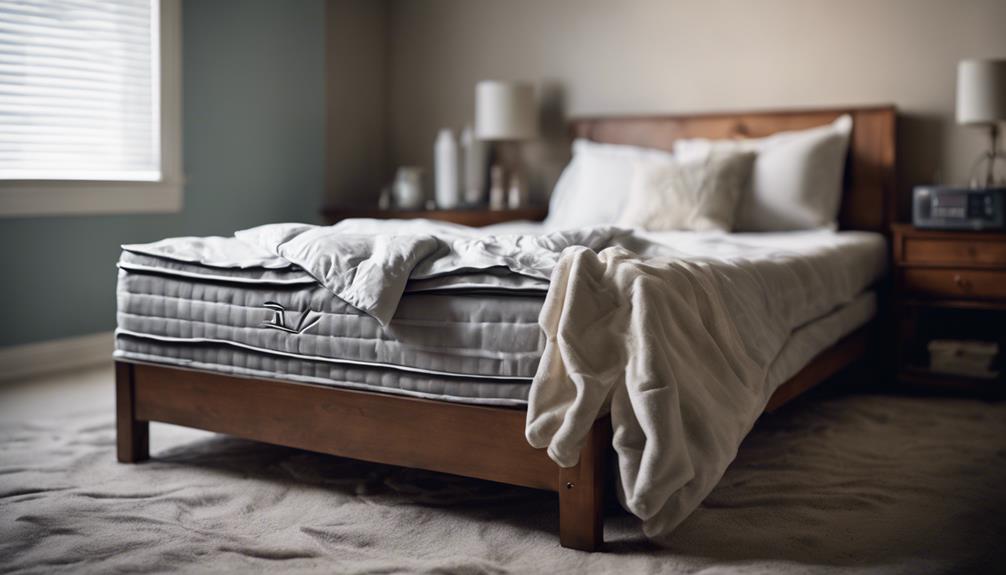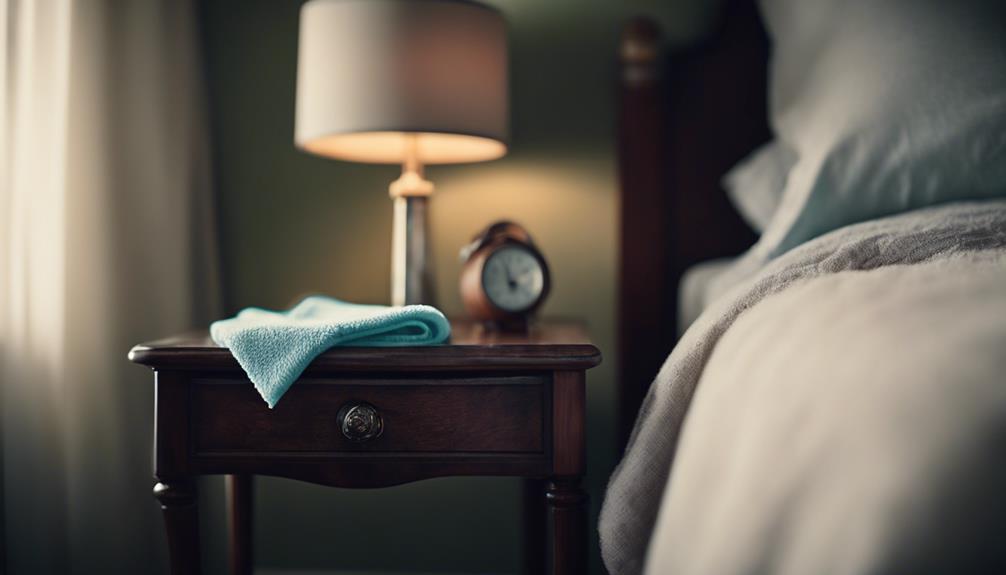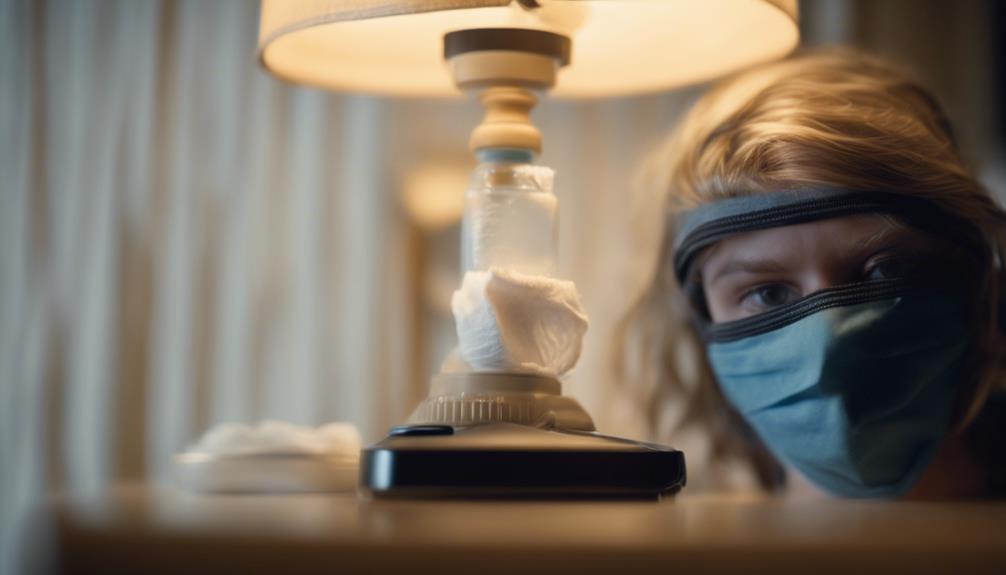Transform your bedroom into an allergen-free haven with these techniques. Opt for damp cloth dusting to trap dust mites efficiently and reduce respiratory irritation. Use a HEPA filter vacuum to capture tiny particles and improve air quality. Shield your bedding with allergen-proof covers for a healthier sleep environment. Wash your bedding weekly in hot water to eliminate dust mites effectively. Dust your bedroom regularly to remove allergens from various surfaces. These methods focus on reducing allergy triggers and enhancing indoor air quality. Further details on allergy-friendly dusting techniques await.
Benefits of Damp Cloth Dusting
Damp cloth dusting greatly enhances allergen removal efficiency in the bedroom. By using a damp cloth, you effectively trap dust mites, pollen, and pet dander, preventing them from becoming airborne and exacerbating allergies. This method is particularly beneficial for individuals prone to respiratory irritation as it minimizes the spread of allergens into the air. When compared to dry dusting, damp cloth dusting proves to be more effective in creating a healthier environment by reducing the presence of allergens on surfaces.
In the bedroom, where we spend a significant amount of time, damp dusting is a simple yet powerful technique to combat allergens. Dust mites, a common trigger for allergies, can be efficiently removed with this method, contributing to a cleaner and safer space for allergy management. Whether you suffer from allergies or simply aim to maintain a healthier living environment, incorporating damp cloth dusting into your cleaning routine can make a noticeable difference in the air quality of your bedroom.
Importance of HEPA Filter Vacuums
Utilizing HEPA filter vacuums is vital for effectively capturing and removing indoor allergens, ensuring a cleaner and healthier bedroom environment for allergy management.
HEPA filter vacuums can capture 99.97% of particles as small as 0.3 microns, including common allergens like dust mites and pet dander. By using a HEPA filter vacuum, you prevent allergens from being released back into the air during cleaning, which is essential for allergy sufferers.
These vacuums are recommended by allergists to improve air quality in the bedroom by reducing indoor allergens. Regular vacuuming with a HEPA filter vacuum significantly reduces the presence of allergens in carpets, rugs, and upholstery.
Investing in a HEPA filter vacuum is a proactive step towards creating an allergy-friendly bedroom environment, as it minimizes dust and allergen exposure, ultimately contributing to better allergy management and overall well-being.
Allergen-Proof Bedding Covers

To create a more allergy-friendly bedroom environment, consider investing in allergen-proof bedding covers. These covers act as barriers against dust mites, pet dander, and other allergens, thanks to their tightly woven fabric that prevents allergens from penetrating. They're designed to be breathable and comfortable, ensuring a restful night's sleep while protecting you from allergens.
Allergen-proof bedding covers are available for pillows, mattresses, and box springs, offering thorough protection. By using these covers, you can greatly reduce allergy symptoms and improve your overall sleep quality. Say goodbye to waking up with a stuffy nose or itchy eyes, as these covers create a shield between you and the allergens that may be affecting your health.
Invest in allergen-proof bedding covers today to transform your bedroom into a sanctuary free from pesky allergens.
Weekly Hot Water Bedding Wash
Consider hot water washing your bedding weekly to effectively eliminate dust mites and allergens, enhancing your bedroom's allergy-friendliness.
Dust mites, common allergens found in bedding, can be effectively eradicated by washing your sheets and pillowcases in hot water at 130°F. Regular hot water washing is essential for allergy prevention as cold water may not eliminate these microscopic pests.
Dust mites thrive in bedding due to the warmth and moisture it provides, making hot water washing an important part of your cleaning routine. The high temperatures of hot water can destroy dust mite proteins that trigger allergic reactions, helping to create a cleaner and healthier sleep environment.
Dusting for Indoor Air Quality

Regular dusting is essential for improving indoor air quality as it removes allergens like dust mites, pollen, and pet dander. These particles can become airborne, triggering allergies and asthma. To effectively trap allergens, use microfiber cloths or electrostatic dusters. Consider adding a small-particle or HEPA filter to your vacuum cleaner to enhance air quality further. Dusting hard-to-reach areas like ceiling fans and vents is crucial in reducing allergen buildup. By incorporating dusting into your weekly cleaning routine, you can significantly decrease allergy triggers in your bedroom and create a healthier living environment.
Creating a cleaner indoor environment through regular dusting is crucial for reducing allergens like dust mites, pollen, and pet dander. These particles can trigger allergies and asthma symptoms by becoming airborne. Using microfiber cloths or electrostatic dusters can effectively trap these allergens. Enhance air quality by adding a small-particle or HEPA filter to your vacuum cleaner. It's essential to dust hard-to-reach areas like ceiling fans and vents to reduce allergen accumulation. By making dusting a part of your weekly cleaning routine, you can lower allergy triggers in your bedroom and promote better health and well-being.
Effective Dust Mite Removal
Getting rid of dust mites from your bedroom is vital for reducing allergy triggers and improving your overall health. Dust mites, microscopic pests that feed on skin flakes, are common in bedding.
To effectively remove them, consider using dust-mite-proof covers on pillows, comforters, mattresses, and box springs. Additionally, washing your bedding weekly in hot water and drying it in a hot dryer can help eliminate these allergens.
Dust mites can trigger allergies and asthma symptoms, underscoring the importance of their removal for a healthier bedroom environment. With potentially up to 10 million dust mites residing in a mattress, regular deep cleaning and protection measures are essential for individuals with allergies.
Consider wearing a dust mask when deep cleaning to avoid inhaling allergens. Using air filters, especially those with HEPA filters, can also help reduce dust mites in the air, further improving the overall air quality in your bedroom.
Microfiber Cloth Dusting

When dusting with a microfiber cloth, you'll find it effective at removing dust particles without spreading them around.
The gentle nature of these cloths makes them suitable for various surfaces, reducing the risk of scratching delicate items.
Effective Dust Removal
Wondering how microfiber cloths make dusting more effective in your bedroom? Here's how they help in removing dust particles and allergens:
- Electrostatic Charge: Microfiber cloths have an electrostatic charge that attracts and traps dust particles, preventing them from becoming airborne.
- Effective Dust Removal: These cloths can capture and hold onto dust, dirt, and allergens without spreading them around, ensuring a thorough clean.
- Gentle on Surfaces: The microfiber material is soft and non-abrasive, making it safe to use on delicate items like electronics and decor.
- Enhanced Dust Capture: Dampening a microfiber cloth can boost its dust removal capabilities by capturing even more particles effectively.
Gentle on Surfaces
Microfiber cloths gently clean surfaces without causing damage or scratches, making them an ideal choice for effective dusting in allergy-friendly bedrooms. These cloths are perfect for gently dusting surfaces due to their ability to trap dust without harming furniture.
Their static charge attracts and holds onto dust particles, making them excellent for allergy-friendly dusting. You can use microfiber cloths dry for light dusting or dampened with water for tougher dirt.
Since they're reusable and washable, they promote allergen-free cleaning and eco-friendly practices. By incorporating microfiber cloths into your dusting routine, you'll reduce allergens in your bedroom, contributing to a cleaner and healthier environment for allergy sufferers.
Reduce Allergy Triggers
To further minimize allergy triggers in your bedroom, consider incorporating the use of microfiber cloths for dusting to effectively capture and remove dust particles that can exacerbate allergies. Here are four reasons why microfiber cloth dusting can help reduce indoor allergies:
- Microfiber cloths trap and hold onto dust particles, preventing them from becoming airborne.
- Damp microfiber cloths capture more dust and allergens than dry dusting methods.
- These cloths are reusable and washable, maintaining their dust-trapping properties.
- Dusting with microfiber cloths eliminates the need for chemical cleaners, promoting a healthier indoor environment.
Dusting to Reduce Allergy Symptoms

Regular dusting is essential in reducing allergy symptoms by removing dust mites and allergens from surfaces. Use a damp or microfiber cloth to trap dust effectively without dispersing it into the air. Pay attention to high surfaces like ceiling fans and light fixtures to prevent allergens from circulating. Vacuum with a HEPA filter to capture allergens on floors and carpets, minimizing allergy triggers. Focus on often overlooked areas such as baseboards and vents to improve indoor air quality significantly. These dusting techniques can reduce allergy symptoms and create a healthier space for you and your loved ones.
Conclusion
To wrap up, by incorporating these allergy-friendly bedroom dusting techniques into your cleaning routine, you can greatly improve indoor air quality and reduce allergy symptoms.
So, grab your trusty microfiber cloth, put on some tunes, and get dusting! Your health and well-being will thank you for it.
Remember, a clean bedroom is like a refreshing breeze in a chaotic world.